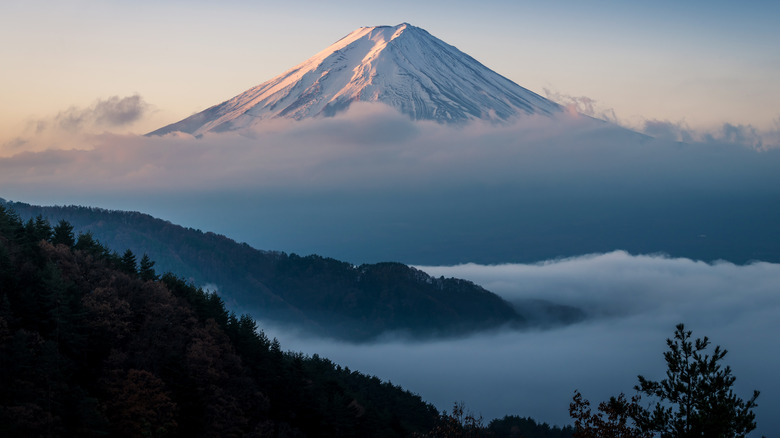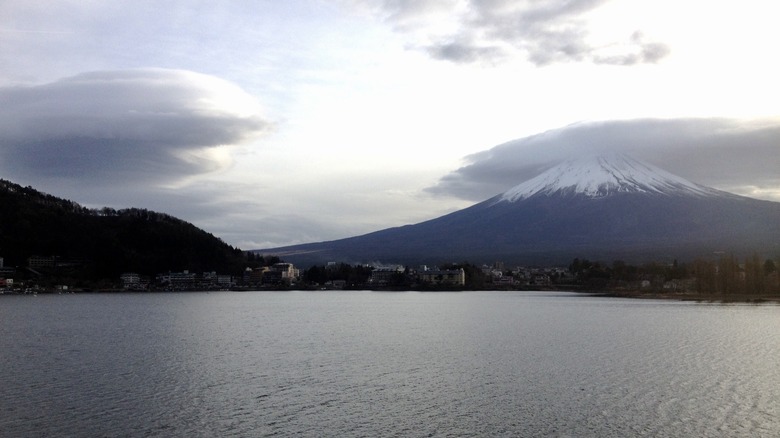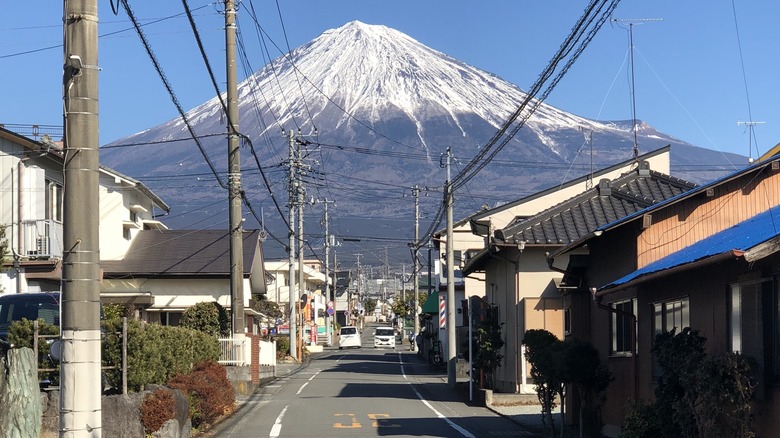Why It's Really Not As Easy As It Seems To See This Big Japanese Tourist Destination
Any day you can see Fujisan — otherwise known as Mount Fuji — is a good day. As an emblem of Japan, the mountain is recognized the world over, with its almost perfect conical shape lending itself naturally to postcards, wall calendars, and travel photos. This has helped make it a UNESCO World Heritage Site and one of Asia's most-filmed locations. If the mountain appears in your first dream of the New Year (known as "hatsuyume" in Japanese), it's considered good luck. However, it might be considered good luck, when you're awake, if you can see Mount Fuji at all. The mountain is often fully or partially obscured by clouds so that it's not visible even from its home in the neighboring prefectures of Shizuoka and Yamanashi.
I've lived in Japan for 14 years, and on holidays, my wife and I regularly go back to her hometown of Fujinomiya, where the Mt. Fuji World Heritage Centre is located. I've seen the mountain from many angles there, along with other parts of Shizuoka (where I once lived) and the Fuji Fives Lakes area in Yamanashi. My mother-in-law worked in one of the mountain's rest stations, and for several years, we tried waking up early to see it with the first sunrise of the New Year. It took six years for us to finally catch Fujisan under just the right weather conditions, without clouds. You don't have to look far online, either, to find people sharing stories of their failed attempts at sighting Mount Fuji.
The best and worst times to see Mount Fuji
Social media is filled with picture-perfect images of Mount Fuji, but many Instagrammers, Redditors, and TikTokers have made it to Japan, only to have disappointing near-misses with the mountain. When you hear enough stories like that based on firsthand travel experience, you might wonder if it's worth going out of your way to see Mount Fuji. It is, but it's good to be mentally prepared should you catch it on a cloudy day.
Mid-to-late summer is when you can enjoy a breathtaking hike to the top, but off the mountain, it tends to be most visible in the winter — and the morning. In 2017, the city of Fuji tracked the mountain's visibility (via Live Japan) and determined that it was fully visible for 24 and 25 days in December and January, respectively. Just two days in July, when the climbing season starts, had all or part of the mountain visible. April, when cherry blossoms are in full bloom in the Fuji Five Lakes area, only had full visibility for seven days.
A winter trip, therefore, is probably your best bet for seeing Mount Fuji, especially if you want to see it snow-capped. If your travel itinerary is fluid, you can try to plan around the local weather forecast. Speaking from personal experience, both on and off the mountain, the view can vary dramatically on the same day as clouds roll in or there's a break in the clouds.
The mountain goddess
On a clear, sunny day, Mount Fuji is right there, looming large over the shrine grounds of Fujisan Hongū Sengen Taisha in Fujinomiya. You can also see it towering over the power lines at the end of some streets. As impressive as such vistas can be, I've grown accustomed to the idea of Mount Fuji having an array of different cloud-based moods. On another day, the same street above might show nothing but clouds.
"She's shy today," my wife might say, as the mountain hides its face (or its whole head) behind a cloudy veil. The Shinto deity Konohanasakuya Hime is identified as the mountain's goddess; she's the one venerated at Sengen shrines across Japan.
Personifying Mount Fuji as a veiled goddess who follows her own whims is maybe a useful mindset to have when you visit Shizuoka or the Fuji Five Lakes area. It's worth remembering that Mount Fuji remains an active stratovolcano, though it's been over 300 years since it last erupted. Nonetheless, some experts have warned that it could erupt again, so it's not a meek mountain that should be expected to perform for anyone's vacation photos. If you show Fujisan respect, who knows, maybe she'll smile down on you and give you a peek at her face, or even throw off the veil entirely. Having this mindset might also make you more appreciative of a rare, auspicious mountain sighting — as if Mount Fuji were showing her face as a blessing on your travels.


